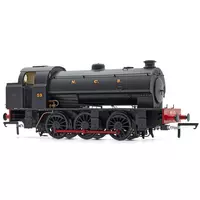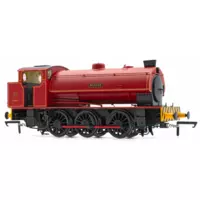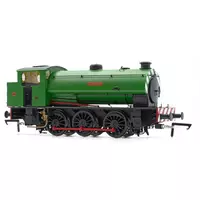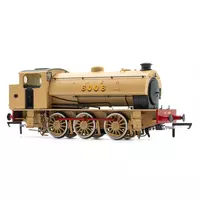Manufacturer catalogue image - please note that pre-release images may be CAD renders or CGI images rather than photographs
Prototype Era
Era 4 (1948 to 1956) British Railways Early Crest
Manufacturer description
The Accurascale Austerity takes the spirit of the real locomotive and is designed to move heavy trains with the minimum of fuss. An all-up weight of nearly 250g and a powerful coreless motor ensures that this locomotive can do just that. Backed up by an on board stay alive power bank, it gives the Accurascale Austerity the reliability to carry on, moving over imperfect track whilst keeping the sounds playing through its pre-fitted twin speakers and the flickering firebox illuminating the highly detailed cab interior.
It’s not just the mechanical and electrical side that impresses, the tooling suite is designed to do this class justice for the first time in 4mm scale. Accurascale have the capability of covering most modifications since the introduction of the type, from the LNER modifications to the bunkers and tank steps, the NCB and Hunslet draughting changes, the cut down cabs of the NCB locomotives working on the Philadelphia system in County Durham and even preservation era modifications. This makes sure that every issue of Accurascale Austerities will be able to bring something “new” to the party.
This locomotive was one of a batch of 36 Austerities by Hudswell Clarke of Leeds. This particular one was completed in November 1944 and carried the WD number 71498. Purchased by the LNER in June 1946 the locomotive was classified as a J94 and numbered 8025. The distinctive extended bunker was fitted in November 1949 when it was renumbered 68025 and gained the early BR emblem. The locomotive was based at Darlington 51A until withdrawal in 1963. The locomotive did not survive and was cut up shortly after. The model replicates the period after 1949 and carries the extended bunker, smokebox numberplate and additional steps and handrails on the tank.
Locomotive Specification
- Highly detailed 0-6-0ST 00 gauge model, 1:76.2 scale on 16.5mm track
- Minimum Radius 438mm (2nd radius set track)
- RP25-110 profile 00 gauge wheels
- Coreless motor with flywheel geared for maximum performance and slow speed running
- Die-cast metal chassis and pickups to all wheels.
- Next18 DCC ready or ESU LokSound V5 sound fitted, slot mounted in smokebox
- PowerPack capacitor for uninterrupted power
- Two quality sugar cube speakers contained in sound capsule located for best possible sound.
- Small, flexible neck NEM coupler mounts set at correct height, with mini-tension-lock couplers.
- Brake rigging factory fitted
- Brake blocks aligned with wheels
- Scale width wire handrails and sand pipes
- Fully detailed cab interior with twin LED pulsing/steady Firebox glow
- Etched metal/plastic detail parts, including grab handles, steps, pipework, lamp irons etc.
- Sliding roof ventilator
- Etched metal pre-painted name plates and works plates.
- Fully sprung metal buffers, factory-installed pipework and screw/3 link couplings
- Magnetically removable smoke box door for DCC decoder access
History
The Hunslet Austerity is arguably one of the most instantly recognisable tank locomotives in the country, with around 485 built and nearly 60 surviving to preservation. Its popularity in preservation means that many enthusiasts will have encountered these simple but powerful machines in action over the last 50 years.
The moniker “Austerity” can be argued as an unfortunate one, as it’s a word which was very much in vogue at the time of their construction in the early 1940s. Thought as simple, rough and almost unwanted machines built for a short term purpose, they were seen as an almost throw away locomotive. The reality couldn’t be further from the truth, with some working until the very end of UK industrial steam in the early 1980s.
During the early part of the 1940s, the Ministry of Supply was on the lookout for a “heavy shunting locomotive” to complement the larger mainline types also being built. Initially the LMS 3F “jinty” was considered but it was Edgar Alcock, Chairman of Hunslet locomotive works in Leeds, that convinced them that a development of their 50550 class was the way forward. One benefit of the Hunslet product was the shorter wheelbase, which would be more forgiving on poorly laid track. Another advantage was the locomotive being a saddle tank. Although this raised the centre of gravity, it gave easier access to the inside motion for maintenance and servicing. One key requirement was that the locomotives would be able to give 2 years of intensive service, regardless of operating conditions. These punchy little tank engines were required to start a train of over 1000 tons on the level and at least 300 tons on a 1 in 50 grade. The pruning of the original 50550 specifications had resulted in quite a formidable machine, seemingly without compromising performance.
The first Austerity steamed at Hunslet’s works on the 1st of January 1943. This was followed by another 149 locomotives over the next 3 years although not all were built by the Leeds based firm. Many were outsourced to builders such as Barclay’s of Kilmarnock, Bagnall’s of Stafford, Yorkshire engine company of Sheffield, Robert Stephenson and Hawthorns of Newcastle and Vulcan Foundry of Newton le Willows, who all fitted their respective builders plates to the locomotives they built to the Hunslet deigns.
The livery was originally a striking “desert sand” colour as specified by the Ministry but later this was changed to a dark green colour. The first were sent to Longmoor and the Shropshire and Montgomeryshire railway (these being fitted with vacuum brakes for passenger working) but they soon found themselves employed in Army depots and shunting yards the length and breadth of the allied rail network. With the cessation of Hostilities in 1945, many of these locomotives were deemed surplus and offered for sale or hire. A total of 27 were hired immediately by the Nederlandsche Spoorwegen (Dutch State Railway) who later went on to purchase them outright, a further 11 went to the Nederlandsche Staatsmijen (Dutch State Mines), two of which were returned later to the WD, the remaining nine becoming the property of the Staatsmijen. Aside from the Dutch locomotives, many simply went in to storage and eventually disappeared from recognition. There were a few taken on by French industrial railways as temporary “power” and there were 6 sold to Chemins de Fer Tunisiens (Tunisian railways) in North Africa.
One of the larger acquisitions was of the 75 locomotives purchased by the LNER. Some of these were second-hand machines but many came “new” from storage and were pressed virtually straight into service, classified as J94’s. Some J94s even retained their WD livery with LNER lettering applied. These LNER locomotives would be passed to British Railways a few years later and they would survive in mainline operation until the mid-1960’s.
However, the LNER wasn’t the biggest customer of the War Dept’s sales. The National Coal Board adopted the design as their “standard” shunter and despatched locomotives to every corner of its operations. From the coalfields of Kent to Scotland, not many NCB sites didn’t house an Austerity (or two). The War Dept didn’t dispose of all of their stock of Austerities and kept 90 of them on the books for working the various depots around the country, notably Longmoor who’s well known lined blue livery was soon applied to their allocation. So successful was the design, it had proved a reliable performer and simple to maintain that further locomotives were ordered direct from Hunslet for the NCB, War Dept and United steel companies (for Exton Park, although the latter were built by the Yorkshire engine company and had a different wheel centre to the earlier Hunslet built machines working at Scunthorpe.)
The standardised nature of the Austerity type meant it was ripe for experimentation and a number of locomotives were fitted with different blastpipe and chimney arrangements in the pursuit of efficiency. First was the Giesl ejector multiple blast pipe arrangement, recognised by its “flat” chimney, locomotives so fitted offered a noticeable reduction in coal usage. A later development was implemented by Hunslet themselves in an attempt to overcome the production of black smoke, as outlawed by the clean air act. This involved a streamlined blast pipe and chimney as pioneered by the Argentinian engineer Livio Dante Porta. Porta had devised number of ways to make the burning of fuel more efficient. The blast nozzle, a Kylpor (Kyläla – Porta) was fitted which gave the exhaust a unique sound, almost like that of a Kylchap (Kyläla – Chapelon) as fitted to LNER A3’s and A4’s. Another feature of the Porta modified Austerities were the over-fire air holes in the sides of the firebox, this allowed additional air to aid the full combustion of firebox gasses before reaching the tubes, also fitted at the time was a mechanical underfeed stoker to enable single man operation.
The last Austerity was built to this design and was rolled out of the Hunslet works in Leeds during 1964. Numbered 3890, this became the very last standard gauge steam locomotive built for use in the British Isles until Tornado was completed in 2008. The number of Austerities in regular service up to and through the 1970s proved to be a real boon to the fledgling preservation scene. Often when locomotives were withdrawn from industrial use they were picked up for scrap value in operational condition by these newly founded preserved railways resulting in nearly 60 overall being saved. They proved invaluable in providing motive power whilst the more glamourous ex-BR types were restored from Barry scrapyard wrecks.
Sadly, for the seemingly unstoppable Austerities, time was called for many and one by one they fell out of use and were shunted to the back of the yards as the more glamourous mainline engines trod the boards with only a few keeping their wheels turning. In more recent years however, the increasing costs for railways, has meant it being largely uneconomical to steam a Class 8 locomotive for a 5 mile trundle with 4 Mk1’s in tow. Things have moved full circle for the Austerity, as second-hand prices have been increasing with railways seeing the true value of an engine that can shift 1000t of train on a ‘few’ buckets of coal.
Catalogue listing
Model details
Prototype information
* Class names often change over the lifespan of a locomotive, so this is not necessarily the class name used by the operator in the period modelled.
Supplier links are provided for your convenience and do not guarantee that the product is currently available. RailwayModels.uk is not a representative of these suppliers, but may receive a commission when purchases are made through links on this page.















